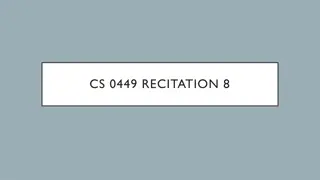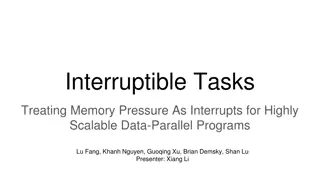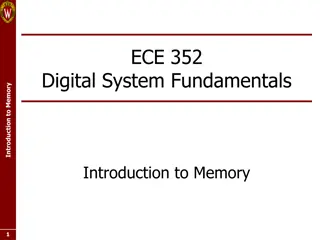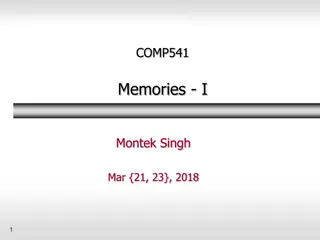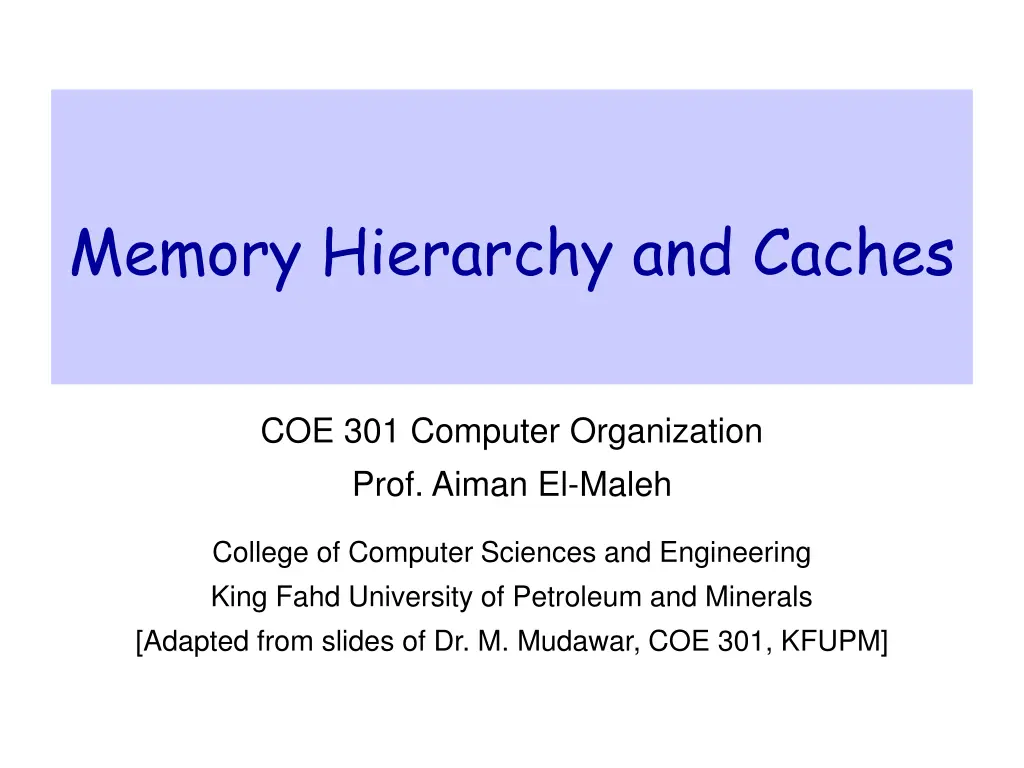
Understanding Memory Hierarchy and Caches in Computer Organization
Explore the essential concepts of memory hierarchy, caches, and memory technologies in computer organization. Learn about Random Access Memory (RAM), memory structure, types of memory technology such as Static RAM (SRAM) and Dynamic RAM (DRAM), and more for efficient computing systems.
Download Presentation

Please find below an Image/Link to download the presentation.
The content on the website is provided AS IS for your information and personal use only. It may not be sold, licensed, or shared on other websites without obtaining consent from the author. If you encounter any issues during the download, it is possible that the publisher has removed the file from their server.
You are allowed to download the files provided on this website for personal or commercial use, subject to the condition that they are used lawfully. All files are the property of their respective owners.
The content on the website is provided AS IS for your information and personal use only. It may not be sold, licensed, or shared on other websites without obtaining consent from the author.
E N D
Presentation Transcript
Memory Hierarchy and Caches COE 301 Computer Organization Prof. Aiman El-Maleh College of Computer Sciences and Engineering King Fahd University of Petroleum and Minerals [Adapted from slides of Dr. M. Mudawar, COE 301, KFUPM]
Presentation Outline Random Access Memory and its Structure Memory Hierarchy and the need for Cache Memory The Basics of Caches Cache Performance and Memory Stall Cycles Improving Cache Performance Multilevel Caches Memory Hierarchy and Caches COE 301 KFUPM slide 2
Random Access Memory Large arrays of storage cells Volatile memory Hold the stored data as long as it is powered on Random Access Access time is practically the same to any data on a RAM chip Output Enable (OE) control signal RAM n Specifies read operation Address Data Write Enable (WE) control signal m OE WE Specifies write operation 2n m RAM chip: n-bit address and m-bit data Memory Hierarchy and Caches COE 301 KFUPM slide 3
Typical Memory Structure Row decoder Select row to read/write Row Decoder Row address 2r 2c m bits Column decoder r . . . Cell Matrix Select column to read/write Cell Matrix Sense/write amplifiers 2D array of tiny memory cells m Data Row Latch 2c m bits Sense/Write amplifiers . . . Sense & amplify data on read Column Decoder Drive bit line with data in on write c Same data lines are used for data in/out Column address Memory Hierarchy and Caches COE 301 KFUPM slide 4
Memory Technology Static RAM (SRAM) for Cache Requires 6 transistors per bit Requires low power to retain bit Dynamic RAM (DRAM) for Main Memory One transistor + capacitor per bit Must be re-written after being read Must also be periodically refreshed Each row can be refreshed simultaneously Address lines are multiplexed Upper half of address: Row Access Strobe (RAS) Lower half of address: Column Access Strobe (CAS) Memory Hierarchy and Caches COE 301 KFUPM slide 5
Static RAM Storage Cell Static RAM (SRAM): fast but expensive RAM 6-Transistor cell with no static current Typically used for caches Word line Vcc Provides fast access time Cell Implementation: Cross-coupled inverters store bit bit bit Two pass transistors Typical SRAM cell Row decoder selects the word line Pass transistors enable the cell to be read and written Memory Hierarchy and Caches COE 301 KFUPM slide 6
Dynamic RAM Storage Cell Dynamic RAM (DRAM): slow, cheap, and dense memory Typical choice for main memory Word line Cell Implementation: Pass Transistor 1-Transistor cell (pass transistor) Trench capacitor (stores bit) Capacitor Bit is stored as a charge on capacitor bit Typical DRAM cell Must be refreshed periodically Because of leakage of charge from tiny capacitor Refreshing for all memory rows Reading each row and writing it back to restore the charge Memory Hierarchy and Caches COE 301 KFUPM slide 7
Typical DRAM Packaging 24-pin dual in-line package for 16Mbit = 222 4 memory Legend 22-bit address is divided into Ai CAS Dj NC OE RAS WE Address bit i Column address strobe Data bit j No connection Output enable Row address strobe Write enable 11-bit row address 11-bit column address Interleaved on same address lines Vss D4 D3 CAS OE A9 A8 A7 A6 A5 A4 Vss 24 23 22 21 20 19 18 17 16 15 14 13 1 2 3 4 5 6 7 8 9 10 11 12 Vcc D1 D2 WE RAS NC A10 A0 A1 A2 A3 Vcc Memory Hierarchy and Caches COE 301 KFUPM slide 8
DRAM Operation Row Access (RAS) Latch and decode row address to enable addressed row Small change in voltage detected by sense amplifiers Latch whole row of bits Sense amplifiers drive bit lines to recharge storage cells Column Access (CAS) read and write operation Latch and decode column address to select m bits m = 4, 8, 16, or 32 bits depending on DRAM package On read, send latched bits out to chip pins On write, charge storage cells to required value Can perform multiple column accesses to same row (burst mode) Memory Hierarchy and Caches COE 301 KFUPM slide 9
Burst Mode Operation Block Transfer Row address is latched and decoded A read operation causes all cells in a selected row to be read Selected row is latched internally inside the SDRAM chip Column address is latched and decoded Selected column data is placed in the data output register Column address is incremented automatically Multiple data items are read depending on the block length Fast transfer of blocks between memory and cache Fast transfer of pages between memory and disk Memory Hierarchy and Caches COE 301 KFUPM slide 10
Trends in DRAM Year Produced 1980 1983 1986 1989 1992 1996 1998 2000 2002 2004 2006 2010 2012 Row access 170 ns 150 ns 120 ns 100 ns 80 ns 70 ns 70 ns 65 ns 60 ns 55 ns 50 ns 35 ns 30 ns Column access 75 ns 50 ns 25 ns 20 ns 15 ns 12 ns 10 ns 7 ns 5 ns 5 ns 3 ns 1 ns 0.5 ns Cycle Time New Request 250 ns 220 ns 190 ns 165 ns 120 ns 110 ns 100 ns 90 ns 80 ns 70 ns 60 ns 37 ns 31 ns Chip size Type 64 Kbit 256 Kbit 1 Mbit 4 Mbit 16 Mbit 64 Mbit 128 Mbit 256 Mbit 512 Mbit 1 Gbit 2 Gbit 4 Gbit 8 Gbit DRAM DRAM DRAM DRAM DRAM SDRAM SDRAM DDR1 DDR1 DDR2 DDR2 DDR3 DDR3 Memory Hierarchy and Caches COE 301 KFUPM slide 11
SDRAM and DDR SDRAM SDRAM is Synchronous Dynamic RAM Added clock to DRAM interface SDRAM is synchronous with the system clock Older DRAM technologies were asynchronous As system bus clock improved, SDRAM delivered higher performance than asynchronous DRAM DDR is Double Data Rate SDRAM Like SDRAM, DDR is synchronous with the system clock, but the difference is that DDR reads data on both the rising and falling edges of the clock signal Memory Hierarchy and Caches COE 301 KFUPM slide 12
Transfer Rates & Peak Bandwidth Standard Name DDR-200 DDR-333 DDR-400 DDR2-667 DDR2-800 DDR2-1066 DDR3-1066 DDR3-1333 DDR3-1600 DDR4-3200 Memory Bus Clock 100 MHz 167 MHz 200 MHz 333 MHz 400 MHz 533 MHz 533 MHz 667 MHz 800 MHz 1600 MHz Millions Transfers per second 200 MT/s 333 MT/s 400 MT/s 667 MT/s 800 MT/s 1066 MT/s 1066 MT/s 1333 MT/s 1600 MT/s 3200 MT/s Module Name PC-1600 PC-2700 PC-3200 PC-5300 PC-6400 PC-8500 PC-8500 PC-10600 PC-12800 PC-25600 Peak Bandwidth 1600 MB/s 2667 MB/s 3200 MB/s 5333 MB/s 6400 MB/s 8533 MB/s 8533 MB/s 10667 MB/s 12800 MB/s 25600 MB/s 1 Transfer = 64 bits = 8 bytes of data Memory Hierarchy and Caches COE 301 KFUPM slide 13
DRAM Refresh Cycles Refresh cycle is about tens of milliseconds Refreshing is done for the entire memory Each row is read and written back to restore the charge Some of the memory bandwidth is lost to refresh cycles Voltage for 1 1 Written Refreshed Refreshed Refreshed Threshold voltage Refresh Cycle 0 Stored Voltage for 0 Time Memory Hierarchy and Caches COE 301 KFUPM slide 14
Expanding the Data Bus Width Memory chips typically have a narrow data bus We can expand the data bus width by a factor of p Use p RAM chips and feed the same address to all chips Use the same Chip Select and Read/Write control signals CS R/W CS R/W CS R/W . . . Address Address Address Data Data Data m m . . Data width = m p bits Memory Hierarchy and Caches COE 301 KFUPM slide 15
Increasing Memory Capacity by 2k A k to 2k decoder is used to select one of the 2k chips Upper n bits of address is fed to all memory chips Lower k bits of address are decoded to select one of the 2k chips Data bus of all chips are wired together Address n+k k k to 2k decoder . . . Only the selected chip will read/write the data n CS R/W CS R/W CS R/W . . . Address Address Address Data Data Data m m m m Data width = m bits Memory Hierarchy and Caches COE 301 KFUPM slide 16
Next . . . Random Access Memory and its Structure Memory Hierarchy and the need for Cache Memory The Basics of Caches Cache Performance and Memory Stall Cycles Improving Cache Performance Multilevel Caches Memory Hierarchy and Caches COE 301 KFUPM slide 17
Processor-Memory Performance Gap CPU Performance: 55% per year, slowing down after 2004 Performance Gap DRAM: 7% per year 1980 No cache in microprocessor 1995 Two-level cache on microprocessor Memory Hierarchy and Caches COE 301 KFUPM slide 18
The Need for Cache Memory Widening speed gap between CPU and main memory Processor operation takes less than 1 ns Main memory requires more than 50 ns to access Each instruction involves at least one memory access One memory access to fetch the instruction A second memory access for load and store instructions Memory bandwidth limits the instruction execution rate Cache memory can help bridge the CPU-memory gap Cache memory is small in size but fast Memory Hierarchy and Caches COE 301 KFUPM slide 19
Typical Memory Hierarchy Registers are at the top of the hierarchy Typical size < 1 KB Access time < 0.5 ns Level 1 Cache (8 64 KB) Microprocessor Access time: 1 ns Registers L2 Cache (512KB 8MB) L1 Cache Access time: 3 10 ns L2 Cache Bigger Faster Main Memory (4 16 GB) Memory Bus Access time: 50 100 ns Main Memory Disk Storage (> 200 GB) I/O Bus Magnetic or Flash Disk Access time: 5 10 ms Memory Hierarchy and Caches COE 301 KFUPM slide 20
Principle of Locality of Reference Programs access small portion of their address space At any time, only a small set of instructions & data is needed Temporal Locality (in time) If an item is accessed, probably it will be accessed again soon Same loop instructions are fetched each iteration Same procedure may be called and executed many times Spatial Locality (in space) Tendency to access contiguous instructions/data in memory Sequential execution of Instructions Traversing arrays element by element Memory Hierarchy and Caches COE 301 KFUPM slide 21
What is a Cache Memory ? Small and fast (SRAM) memory technology Stores the subset of instructions & data currently being accessed Used to reduce average access time to memory Caches exploit temporal locality by Keeping recently accessed data closer to the processor Caches exploit spatial locality by Moving blocks consisting of multiple contiguous words Goal is to achieve Fast speed of cache memory access Balance the cost of the memory system Memory Hierarchy and Caches COE 301 KFUPM slide 22
Cache Memories in the Datapath Imm16 Imm E ALU result 32 0 1 32 A ALUout I-Cache Register File 2 3 BusA D-Cache Address 5 Instruction Rs A L U 0 WB Data RA Instruction Rt 5 32 BusB 0 1 RB Data_out PC Address 1 1 0 B Data_in RW 2 3 D BusW 32 32 0 1 Rd2 Rd3 Rd4 Rd clk Instruction Block Block Address Block Address D-Cache miss I-Cache miss I-Cache miss or D-Cache miss causes pipeline to stall Data Block Interface to L2 Cache or Main Memory Memory Hierarchy and Caches COE 301 KFUPM slide 23
Almost Everything is a Cache ! In computer architecture, almost everything is a cache! Registers: a cache on variables software managed First-level cache: a cache on second-level cache Second-level cache: a cache on memory Memory: a cache on hard disk Stores recent programs and their data Hard disk can be viewed as an extension to main memory Branch target and prediction buffer Cache on branch target and prediction information Memory Hierarchy and Caches COE 301 KFUPM slide 24
Next . . . Random Access Memory and its Structure Memory Hierarchy and the need for Cache Memory The Basics of Caches Cache Performance and Memory Stall Cycles Improving Cache Performance Multilevel Caches Memory Hierarchy and Caches COE 301 KFUPM slide 25
Four Basic Questions on Caches Q1: Where can a block be placed in a cache? Block placement Direct Mapped, Set Associative, Fully Associative Q2: How is a block found in a cache? Block identification Block address, tag, index Q3: Which block should be replaced on a miss? Block replacement FIFO, Random, LRU Q4: What happens on a write? Write strategy Write Back or Write Through (with Write Buffer) Memory Hierarchy and Caches COE 301 KFUPM slide 26
Block Placement: Direct Mapped Block: unit of data transfer between cache and memory Direct Mapped Cache: A block can be placed in exactly one location in the cache 000 001 010 100 101 110 011 111 In this example: Cache index = least significant 3 bits of Memory address Cache Memory Main 00000 00001 00010 00100 00101 01000 01001 01010 10000 10001 10010 10100 10101 11000 11010 11001 00110 01100 01101 10110 00011 01011 10011 11100 11101 00111 01110 10111 11011 11110 01111 11111 Memory Hierarchy and Caches COE 301 KFUPM slide 27
Direct-Mapped Cache A memory address is divided into Block Address Block address: identifies block in memory Tag Index offset Block offset: to access bytes within a block A block address is further divided into V Tag Block Data Index: used for direct cache access Tag: most-significant bits of block address Index = Block AddressmodCache Blocks Tag must be stored also inside cache For block identification = A valid bit is also required to indicate Data Hit Whether a cache block is valid or not Memory Hierarchy and Caches COE 301 KFUPM slide 28
Direct Mapped Cache contd Cache hit: block is stored inside cache Index is used to access cache block Address tag is compared against stored tag If equal and cache block is valid then hit Otherwise: cache miss If number of cache blocks is 2n n bits are used for the cache index If number of bytes in a block is 2b b bits are used for the block offset If 32 bits are used for an address 32 n b bits are used for the tag Cache data size = 2n+b bytes Block Address Tag Index offset V Tag Block Data = Data Hit Memory Hierarchy and Caches COE 301 KFUPM slide 29
Mapping an Address to a Cache Block Example Consider a direct-mapped cache with 256 blocks Block size = 16 bytes Compute tag, index, and byte offset of address: 0x01FFF8AC Block Address Solution 20 8 4 32-bit address is divided into: Tag Index offset 4-bit byte offset field, because block size = 24 = 16 bytes 8-bit cache index, because there are 28 = 256 blocks in cache 20-bit tag field Byte offset = 0xC = 12 (least significant 4 bits of address) Cache index = 0x8A = 138 (next lower 8 bits of address) Tag = 0x01FFF (upper 20 bits of address) Memory Hierarchy and Caches COE 301 KFUPM slide 30
Example on Cache Placement & Misses Consider a small direct-mapped cache with 32 blocks Cache is initially empty, Block size = 16 bytes The following memory addresses (in decimal) are referenced: 1000, 1004, 1008, 2548, 2552, 2556. Map addresses to cache blocks and indicate whether hit or miss 5 23 4 Solution: 1000 = 0x3E8 1004 = 0x3EC cache index = 0x1E 1008 = 0x3F0 2548 = 0x9F4 2552 = 0x9F8 2556 = 0x9FC cache index = 0x1F Tag Index offset cache index = 0x1E Miss (first access) Hit Miss (first access) Miss (different tag) Hit Hit cache index = 0x1F cache index = 0x1F cache index = 0x1F Memory Hierarchy and Caches COE 301 KFUPM slide 31
Fully Associative Cache A block can be placed anywhere in cache no indexing If m blocks exist then m comparators are needed to match tag Cache data size = m 2b bytes Address Tag offset V Tag Block Data V Tag Block Data V Tag Block Data V Tag Block Data = = = = mux m-way associative Data Hit Memory Hierarchy and Caches COE 301 KFUPM slide 32
Set-Associative Cache A set is a group of blocks that can be indexed A block is first mapped onto a set Set index = Block addressmodNumber of sets in cache If there are m blocks in a set (m-way set associative) then m tags are checked in parallel using m comparators If 2n sets exist then set index consists of n bits Cache data size = m 2n+b bytes (with 2b bytes per block) Without counting tags and valid bits A direct-mapped cache has one block per set (m = 1) A fully-associative cache has one set (2n = 1 or n = 0) Memory Hierarchy and Caches COE 301 KFUPM slide 33
Set-Associative Cache Diagram Address Tag Index offset V Tag Block Data V Tag Block Data V Tag Block Data V Tag Block Data = = = = mux m-way set-associative Hit Data Memory Hierarchy and Caches COE 301 KFUPM slide 34
Write Policy Write Through: Writes update cache and lower-level memory Cache control bit: only a Valid bit is needed Memory always has latest data, which simplifies data coherency Can always discard cached data when a block is replaced Write Back: Writes update cache only Cache control bits: Valid and Modifiedbits are required Modified cached data is written back to memory when replaced Multiple writes to a cache block require only one write to memory Uses less memory bandwidth than write-through and less power However, more complex to implement than write through Memory Hierarchy and Caches COE 301 KFUPM slide 35
Write Miss Policy What happens on a write miss? Write Allocate: Allocate new block in cache Write miss acts like a read miss, block is fetched and updated No Write Allocate: Send data to lower-level memory Cache is not modified Typically, write back caches use write allocate Hoping subsequent writes will be captured in the cache Write-through caches often use no-write allocate Reasoning: writes must still go to lower level memory Memory Hierarchy and Caches COE 301 KFUPM slide 36
Write Buffer Decouples the CPU write from the memory bus writing Permits writes to occur without stall cycles until buffer is full Write-through: all stores are sent to lower level memory Write buffer eliminates processor stalls on consecutive writes Write-back: modified blocks are written when replaced Write buffer is used for evicted blocks that must be written back The address and modified data are written in the buffer The write is finished from the CPU perspective CPU continues while the write buffer prepares to write memory If buffer is full, CPU stalls until buffer has an empty entry Memory Hierarchy and Caches COE 301 KFUPM slide 37
What Happens on a Cache Miss? Cache sends a miss signal to stall the processor Decide which cache block to allocate/replace One choice only when the cache is directly mapped Multiple choices for set-associative or fully-associative cache Transfer the block from lower level memory to this cache Set the valid bit and the tag field from the upper address bits If block to be replaced is modified then write it back Modified block is moved into a Write Buffer Otherwise, block to be replaced can be simply discarded Restart the instruction that caused the cache miss Miss Penalty: clock cycles to process a cache miss Memory Hierarchy and Caches COE 301 KFUPM slide 38
Replacement Policy Which block to be replaced on a cache miss? No selection alternatives for direct-mapped caches m blocks per set to choose from for associative caches Random replacement Candidate blocks are randomly selected One counter for all sets (0 to m 1): incremented on every cycle On a cache miss replace block specified by counter First In First Out (FIFO) replacement Replace oldest block in set One counter per set (0 to m 1): specifies oldest block to replace Counter is incremented on a cache miss Memory Hierarchy and Caches COE 301 KFUPM slide 39
Replacement Policy contd Least Recently Used (LRU) Replace block that has been unused for the longest time Order blocks within a set from least to most recently used Update ordering of blocks on each cache hit With m blocks per set, there are m! possible permutations Pure LRU is too costly to implement when m > 2 m = 2, there are 2 permutations only (a single bit is needed) m = 4, there are 4! = 24 possible permutations LRU approximation is used in practice For large m > 4, Random replacement can be as effective as LRU Memory Hierarchy and Caches COE 301 KFUPM slide 40
Comparing Random, FIFO, and LRU Data cache misses per 1000 instructions 10 SPEC2000 benchmarks on Alpha processor Block size of 64 bytes LRU and FIFO outperforming Random for a small cache Little difference between LRU and Random for a large cache LRU is expensive for large associativity (# blocks per set) Random is the simplest to implement in hardware 2-way 4-way 8-way Size LRU Rand FIFO LRU Rand FIFO LRU Rand FIFO 16 KB 114.1 117.3 115.5 111.7 115.1 113.3 109.0 111.8 110.4 64 KB 103.4 104.3 103.9 102.4 102.3 103.1 99.7 100.5 100.3 256 KB 92.2 92.1 92.5 92.1 92.1 92.5 92.1 92.1 92.5 Memory Hierarchy and Caches COE 301 KFUPM slide 41
Next . . . Random Access Memory and its Structure Memory Hierarchy and the need for Cache Memory The Basics of Caches Cache Performance and Memory Stall Cycles Improving Cache Performance Multilevel Caches Memory Hierarchy and Caches COE 301 KFUPM slide 42
Hit Rate and Miss Rate Hit Rate = Hits / (Hits + Misses) Miss Rate = Misses / (Hits + Misses) I-Cache Miss Rate = Miss rate in the Instruction Cache D-Cache Miss Rate = Miss rate in the Data Cache Example: Out of 1000 instructions fetched, 150 missed in the I-Cache 25% are load-store instructions, 50 missed in the D-Cache What are the I-cache and D-cache miss rates? I-Cache Miss Rate = 150 / 1000 = 15% D-Cache Miss Rate = 50 / (25% 1000) = 50 / 250 = 20% Memory Hierarchy and Caches COE 301 KFUPM slide 43
Memory Stall Cycles The processor stalls on a Cache miss When fetching instructions from the Instruction Cache (I-cache) When loading or storing data into the Data Cache (D-cache) Memory stall cycles = Combined Misses Miss Penalty Miss Penalty: clock cycles to process a cache miss Combined Misses = I-Cache Misses + D-Cache Misses I-Cache Misses = I-Count I-Cache Miss Rate D-Cache Misses = LS-Count D-Cache Miss Rate LS-Count (Load & Store) = I-Count LS Frequency Cache misses are often reported per thousand instructions Memory Hierarchy and Caches COE 301 KFUPM slide 44
Memory Stall Cycles Per Instruction Memory Stall Cycles Per Instruction = Combined Misses Per Instruction Miss Penalty Miss Penalty is assumed equal for I-cache & D-cache Miss Penalty is assumed equal for Load and Store Combined Misses Per Instruction = I-Cache Miss Rate + LS Frequency D-Cache Miss Rate Therefore, Memory Stall Cycles Per Instruction = I-Cache Miss Rate Miss Penalty + LS Frequency D-Cache Miss Rate Miss Penalty Memory Hierarchy and Caches COE 301 KFUPM slide 45
Example on Memory Stall Cycles Consider a program with the given characteristics Instruction count (I-Count) = 106 instructions 30% of instructions are loads and stores D-cache miss rate is 5% and I-cache miss rate is 1% Miss penalty is 100 clock cycles for instruction and data caches Compute combined misses per instruction and memory stall cycles Combined misses per instruction in I-Cache and D-Cache 1% + 30% 5% = 0.025 combined misses per instruction Equal to 25 misses per 1000 instructions Memory stall cycles 0.025 100 (miss penalty) = 2.5 stall cycles per instruction Total memory stall cycles = 106 2.5 = 2,500,000 Memory Hierarchy and Caches COE 301 KFUPM slide 46
CPU Time with Memory Stall Cycles CPU Time = I-Count CPIMemoryStalls Clock Cycle CPIMemoryStalls = CPIPerfectCache + Mem Stalls per Instruction CPIPerfectCache = CPI for ideal cache (no cache misses) CPIMemoryStalls = CPI in the presence of memory stalls Memory stall cycles increase the CPI Memory Hierarchy and Caches COE 301 KFUPM slide 47
Example on CPI with Memory Stalls A processor has CPI of 1.5 without any memory stalls Cache miss rate is 2% for instruction and 5% for data 20% of instructions are loads and stores Cache miss penalty is 100 clock cycles for I-cache and D-cache What is the impact on the CPI? Answer: Mem Stalls per Instruction = CPIMemoryStalls = CPIMemoryStalls / CPIPerfectCache = Processor is 3 times slower due to memory stall cycles CPINoCache = 1.5 + (1 + 0.2) 100 = 121.5 (a lot worse) Instruction data 0.02 100 + 0.2 0.05 100 = 3 1.5 + 3 = 4.5 cycles per instruction 4.5 / 1.5 = 3 Memory Hierarchy and Caches COE 301 KFUPM slide 48
Average Memory Access Time Average Memory Access Time (AMAT) AMAT = Hit time + Miss rate Miss penalty Time to access a cache for both hits and misses Example: Find the AMAT for a cache with Cache access time (Hit time) of 1 cycle = 2 ns Miss penalty of 20 clock cycles Miss rate of 0.05 per access Solution: AMAT = 1 + 0.05 20 = 2 cycles = 4 ns Without the cache, AMAT will be equal to Miss penalty = 20 cycles Memory Hierarchy and Caches COE 301 KFUPM slide 49
Average Memory Access Time AMAT(IC) = Hit time(IC) + Miss rate(IC) Miss penalty AMAT(DC) = Hit time(DC) + Miss rate(DC) Miss penalty AMAT = 1/(1+PLS)*AMAT(IC) + PLS/(1+PLS)*AMAT(DC) PLS is the probability of Load/Store instructions 1/(1+PLS) is the probability of accessing the instruction cache PLS/(1+PLS) is the probability of accessing the data cache Memory Hierarchy and Caches COE 301 KFUPM slide 50







